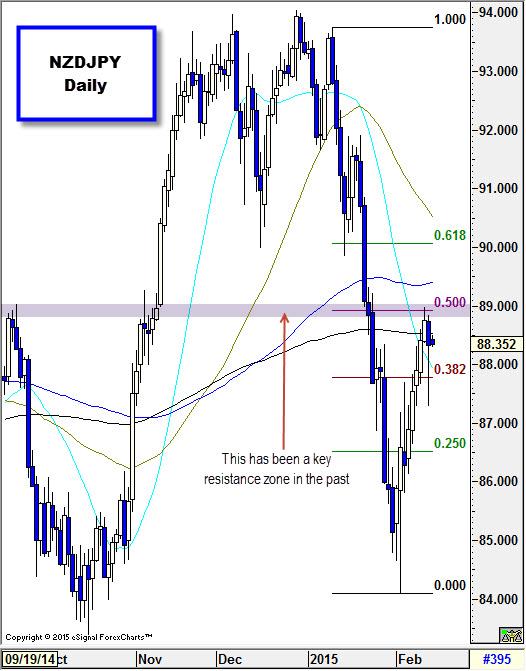![]()
NZDJPY bulls overpower the bears
However, this began to change earlier this month with the release of some encouraging economic data from NZ. On the same day that the GlobalDairyTrade Price Index recorded a reassuring 9.4% jump, Statistics New Zealand released an encouraging Q4 employment report. Employment increased 1.2% q/q and people flocked back into the labour force.
This helped to spark a rally in NZDJPY which sent the pair around 500 pips higher at its highest point. However, the rally ran out of steam about halfway to where the aforementioned sell-off began, which also happens to coincide with an important long-term resistance zone (see chart). A rejection here may mean that price is losing upward momentum. In fact, it has already started to drift lower.
Uncertainty has trapped NZDJPY
It looks like uncertainty has killed the pair. The market is still trying to figure what the RBNZ’s next move will be and when. There is also the question of whether the BoJ will pump even more stimulus into the economy; we expect the BoJ to hold off in the near-term but if inflation continues to falter in Japan the BoJ won’t hesitate to expand its already massive QQE program. With the outlook for monetary policy in Japan and NZ up the air at the moment, NZDJPY has lost its engine and it’s no surprise that NZDJPY’s retracement has stalled and some techs have turned negative, thus our bias is lower at the moment.

Source: FOREX.com
Recommended Content
Editors’ Picks
EUR/USD edges lower toward 1.0700 post-US PCE

EUR/USD stays under modest bearish pressure but manages to hold above 1.0700 in the American session on Friday. The US Dollar (USD) gathers strength against its rivals after the stronger-than-forecast PCE inflation data, not allowing the pair to gain traction.
GBP/USD retreats to 1.2500 on renewed USD strength

GBP/USD lost its traction and turned negative on the day near 1.2500. Following the stronger-than-expected PCE inflation readings from the US, the USD stays resilient and makes it difficult for the pair to gather recovery momentum.
Gold struggles to hold above $2,350 following US inflation

Gold turned south and declined toward $2,340, erasing a large portion of its daily gains, as the USD benefited from PCE inflation data. The benchmark 10-year US yield, however, stays in negative territory and helps XAU/USD limit its losses.
Bitcoin Weekly Forecast: BTC’s next breakout could propel it to $80,000 Premium

Bitcoin’s recent price consolidation could be nearing its end as technical indicators and on-chain metrics suggest a potential upward breakout. However, this move would not be straightforward and could punish impatient investors.
Week ahead – Hawkish risk as Fed and NFP on tap, Eurozone data eyed too

Fed meets on Wednesday as US inflation stays elevated. Will Friday’s jobs report bring relief or more angst for the markets? Eurozone flash GDP and CPI numbers in focus for the Euro.